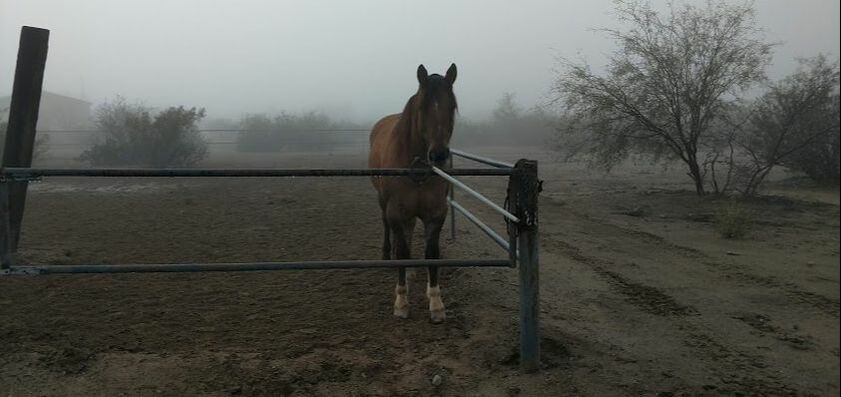|
This post may contain affiliate or sponsored links. Please read our Privacy Policy and Disclaimer. At my Tucson horse boarding facility, I can ride year-round, but I spent 16 years in the frozen white North of Montana, and I know how excited I was to start riding again after the snow was off the ground (in April…or May…or June). While it’s tempting to jump right into event-specific training, after a long break your horse needs conditioning to reach his peak fitness level, whether you are competing or riding for pleasure. Taking the time to properly condition your horse is your best prevention against injuries and creates a fit, willing partner for your riding season (bonus: you get fit as well!) This is the fitness plan I used each Spring with my horses for eight weeks before we start working on the skills we need in the show ring. Is Your Horse Ready for Conditioning? Before you condition your horse, consider these points:
Determine Your Horse’s Baseline Fitness Level The first step in creating an effective conditioning program is to determine your horse’s baseline fitness level. Before you know where you need to go, you need to know where you are starting. There’s no “one size fits all” baseline fitness level because all horses spend their off season in different situations. A horse that spent the winter in his stall and in a small turnout area will be far less fit than a horse who wintered in a large pasture with varied terrain. For the first ride, walk your horse under saddle for 30 minutes. Dismount and check his pulse rate. Recheck every two minutes until it is down to 60 beats per minute. If your horse returns to this heartrate within five to ten minutes, he is fit at this level, and you can move onto the next one. When you find the level where your horse cannot recover to a pulse rate of 60 beats per minute within ten minutes of the end of exercise, that is the level where you need to train for the next week. You have three options for taking your horse’s pulse.
Conditioning Levels If I am conditioning a horse for the first time, or the first time after a long break, these are the levels I use. I start at the level where he cannot return to a pulse rate of 60 beats per minute within ten minutes, work at that level for one week, and recheck his recovery rate. If his pulse rate recovers ten minutes (ideally within five minutes), I move onto the next level. If not, I spend another week at the same level. I ride each horse five to six days a week. Week 1: 30 minute ride, 12.5 minutes walking, five minutes trotting, 12.5 minute walking, flat terrain (such as my arena or the county road). Week 2: 30 minute ride, 12.5 minutes walking, five minutes trotting, 12.5 minutes walking, varied terrain (hills). Week 3: 30 minute ride, 10 minutes walking, 10 minutes trotting, 10 minutes walking, flat terrain. Week 4: 30 minute ride, 10 minutes walking, 10 minutes trotting, 10 minutes walking, varied terrain. Week 5: 30 minute ride, 5 minutes walking, 10 minutes trotting, 5 minutes walking, 5 minutes loping, 5 minutes walking , flat terrain. Week 6: 30 minute ride, 5 minutes walking, 10 minutes trotting, 5 minutes waking, 5 minutes loping, 5 minutes walking, varied terrain. Week 7: 45 minute ride, 10 minutes walking, 15 minutes trotting, 5 minutes walking, 10 minutes loping, 5 minutes walking, flat terrain. Week 8: 45 minutes ride, 10 minutes walking, 15 minutes trotting, 5 minutes walking, 10 minutes loping, 5 minutes walking, varied terrain. The walk should be energetic and elastic. Don’t allow your horse to just plod along. The trot should be an extended trot, and posting will put less strain on your horse’s back. Lope at whatever speed feels natural for your horse. Keep gentle contact with the bit but allow your horse to extend his head as far forward as he wants. Do not keep him in a frame while conditioning him.
By the end of the eight-week conditioning period, if your horse’s pulse rate recovers within ten minutes (ideally five minutes) he will have the cardiovascular and muscular endurance to participate in most equine events. If your horse develops back soreness or becomes generally sour, back off the conditioning program until you determine the cause. You may need to replace your saddle, get your horse a chiropractic adjustment, make an appointment with the farrier, or call the vet. If you are training hard (five to six days a week) and your horse is generally sour but showing no signs of pain, he may be experiencing burnout. Reduce the number of days you work him each week or mix up his routine (ride with friends, try a new trail, haul to a new arena). Dedicate the Time Conditioning your horse is a long process, especially if your horse has been sedentary for a long period or has never been conditioned before. However, this process produces a sound, fit, enthusiastic partner for whatever equine event you want to do. Follow this process through to prevent injuries and to keep your horse active for many years to come. What are your best tips for conditioning your horse? Let me know in the comments below!
8 Comments
Toni
1/19/2019 06:12:12 am
Great article! Looking forward to implementing this into my training! Excited to see both of get fitter this show season!
Reply
Alissa Berry
1/25/2019 08:34:44 am
So often fitness (for horse and rider) gets overlooked. Good luck on a great riding season!
Reply
Kim Van Drisse
4/1/2019 08:55:38 am
Here in Wisconsin, I moved my horse to a barn with an indoor in early March, there was still alot of snow/ice on the ground so we've been working indoors. She's been turned out on pasture since November. While she has the ability to move around 24/7, which is better than being stalled, she did lose condition.
Reply
Alissa Berry
4/4/2019 06:57:08 am
It sounds like you have developed a great plan for getting your horse back in condition! I feel for you living in the cold, white North with a short riding season. It's tough in the spring when all you want is warm weather and all you get is snow.
Reply
Tamra Ely
6/25/2019 10:31:14 am
thank you for this very informative info. I have been wondering how best to bring my horse back to fitness after a stifle injury. She has been given the go ahead by my vet after being off for one year. sounds like a good program. I am always open to ideas and suggestions. Getting back in the saddle. I to have been off for one year due to braking my leg. I think your program will help us both. Tamra
Reply
7/3/2019 07:34:09 am
Good luck! Proper conditioning takes a long time but has huge benefits. Take your time and you and your horse will both be fit and fabulous!
Reply
May Pin
11/12/2023 07:07:32 am
Hi.
Reply
1/8/2024 04:48:43 am
Reference health websites:
Reply
Leave a Reply. |
AuthorWelcome! I've been a freelance writer since 2002 and have numerous horse-related articles published in print and online publications. I have a Bachelor of Science degree from Rocky Mountain College with a major in Equestrian Studies and a minor in Business Management. My current business ventures include High Plains Arena and real estate investing. Archives
March 2019
Categories
All
|
Proudly powered by Weebly




 RSS Feed
RSS Feed